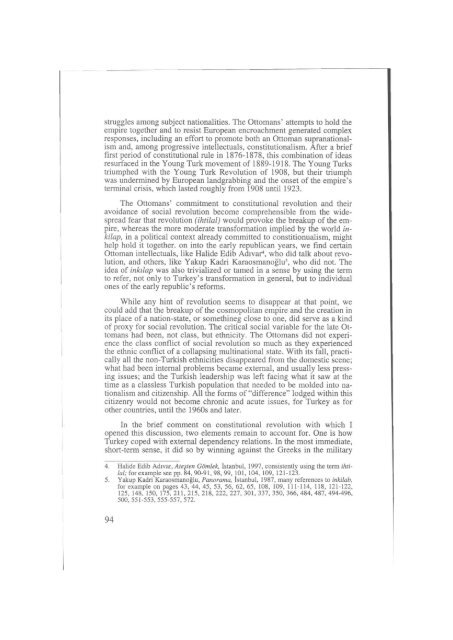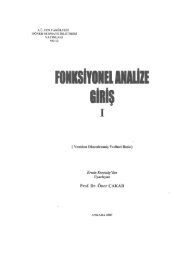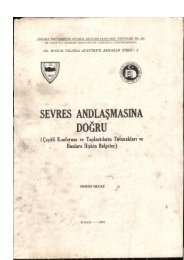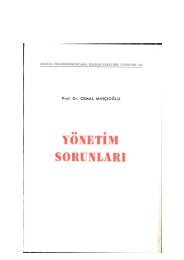- Page 1:
TÜRKİYE CUMHURİYETİNİN YETMİ
- Page 4 and 5:
ISBN 975-482-481-9Ankara Üniversit
- Page 6 and 7:
Gazmend SHPUZA: Arnavutluk İle Tü
- Page 8:
Prof. Dr. Zheng-hua DONG: Chinese V
- Page 11 and 12:
ÖNSÖZTürkiye Cumhuriyeti'nin 75.
- Page 13:
SUNUŞKonferansımız Atatürk, Ata
- Page 16 and 17:
dır. Mustafa Kemal'in 1920-1921 y
- Page 18 and 19:
yasal partilerin, sendikaların, me
- Page 21 and 22:
TÜRK DEVRIMININ DEMOKRASI KURAMıN
- Page 23 and 24:
iner ideolojik kalıplar altına d
- Page 25 and 26:
aştacı edildiği bir çağda müs
- Page 27 and 28:
diyordu, "Değişmelerin sabit ve d
- Page 29 and 30:
"Devletin temel görevlerini gereğ
- Page 31 and 32:
'Devletin ekonomik etkinliklerinin
- Page 33 and 34:
THE NATURE OF THE KEMALIST REVOLUT
- Page 35:
cal aspect of Kemalism as the "limi
- Page 38 and 39:
economy, provided its workers with
- Page 40 and 41:
Some people in Turkey, unfortunatel
- Page 42 and 43:
parties and socialist publications.
- Page 44 and 45:
A set of causes explains this protr
- Page 46 and 47:
Mustafa Kemal, the most outstanding
- Page 48 and 49:
ness, faced by the need to have the
- Page 50 and 51:
lims, it had a strong demonstrative
- Page 52 and 53:
leader, Kemal Atatürk, whose think
- Page 55 and 56:
ATATÜRKISM AN INITIATIVE OF A MODE
- Page 57 and 58: applied in the 30 s has been influe
- Page 59 and 60: conditioned on some incomplete aspe
- Page 61 and 62: ATATÜRK AND THE ıDEA OF A REPUBLI
- Page 63: He gave up the idea of maintaining
- Page 66 and 67: nin değerleri ile kesişmiyordu. A
- Page 68 and 69: nm farkedilmemesi mümkün değildi
- Page 70 and 71: haklarının, azınlıkların tanı
- Page 73 and 74: HıZLı ÇAĞDAŞLAŞMA MODELI OLAR
- Page 75 and 76: duğu ve bunu çok hızlı ve süre
- Page 77 and 78: Türkiye'yi, bir zamanlar bütün
- Page 79: Bugünün Türk gençliğinin aşı
- Page 82 and 83: lenemez Yunus Emre "yetmiş iki mil
- Page 84 and 85: Şu halde Atatürk'ün hümanist d
- Page 87 and 88: ÇAĞDAŞ TÜRKIYE'NIN TEMELI KEMAL
- Page 89 and 90: iya, tabandan tavana sağlam bir ya
- Page 91 and 92: ikliğe göre, insan yaşamında ib
- Page 93 and 94: ması gerekmekteydi. Bu anlayış T
- Page 95 and 96: - Ziraat okulları açılarak, tar
- Page 97 and 98: da iktisadiyat gibi) siyasî açıd
- Page 99 and 100: MUSTAFA KEMAL ATATÜRKProf. Dr. Kam
- Page 101 and 102: Raised from early childhood in a no
- Page 103 and 104: ing, meant that the old order had t
- Page 105 and 106: REFLECTıONS ON THE EARLY TURKISHRE
- Page 107: evolutions and social revolutions.
- Page 111 and 112: away probably came up with with sim
- Page 113 and 114: MUSTAFA KEMAL TÜRKIYESI VE AVRUPAO
- Page 115 and 116: kültürünü unutmadan ilerleme yo
- Page 117 and 118: DE GAULLE'S TURKEYEdouard SABLIER*L
- Page 119 and 120: paid a hcariful hommage to the Maus
- Page 121 and 122: TÜRKIYE CUMHURIYETI'NIN BALKANDEVL
- Page 123 and 124: Ankara 'da şanlı orduHer tarafa
- Page 125 and 126: cukluğundan ölümüne dek yaşam
- Page 127 and 128: İnönü Dağları 'ndan neferler g
- Page 129 and 130: turyalıların ve Krallık Yugoslav
- Page 131 and 132: sonra "Bu şekildeki Türkiye, ger
- Page 133 and 134: oluşan "Savremena Turska" (Çağda
- Page 135 and 136: Daha geçlerde, özellikle Atatürk
- Page 137 and 138: Alirıza Saraçoğlu'ndan başka Ra
- Page 139 and 140: Durmak" yazılan ile ve "Atatürk
- Page 141: "Bu yapıtı okurken, Yunan tarafı
- Page 144 and 145: kabul görmüştür. Aynı dönemde
- Page 146 and 147: icat fiili ricata dönüşürken, H
- Page 148 and 149: ir dönemde Türkiye'nin herhangi b
- Page 150 and 151: zaafı sorunsalından yola çıkıl
- Page 152 and 153: yönetiminin ve egemenliğinin Tür
- Page 154 and 155: önceliği vardı. Uluslararası si
- Page 156 and 157: karak bu dönemde dış politikayı
- Page 158 and 159:
dünyada uluslararası ilişkilerde
- Page 160 and 161:
kadar direktiflerinde Bulgarlarla i
- Page 162 and 163:
andlaşmayı yenilen bir devlet ola
- Page 164 and 165:
kanına göre, anlaşmalarının im
- Page 166 and 167:
uları yanıtlamıştır. Uyumu boz
- Page 168 and 169:
liyiz ki son 20 yıl içersinde Tü
- Page 170 and 171:
Bu belgelerden (en önemlisi olan L
- Page 172 and 173:
hası, Patriklik kurumu büyük ola
- Page 174 and 175:
İkinci maddenin sonucunda yaklaş
- Page 176 and 177:
yaklaşık beş yüze gerileyerek,
- Page 178 and 179:
Önemli bir bölümü İstanbul'da
- Page 180 and 181:
tayin edildiler ve bu özellikle Po
- Page 182 and 183:
demiştir. Yunanistan'ı savunması
- Page 184 and 185:
Genel Değerlendirme: Bu baskılar
- Page 186 and 187:
) Küreselleşme rüzgarları: İlk
- Page 189 and 190:
ARNAVUTLUK İLE TÜRKİYE ARASINDAD
- Page 191 and 192:
Uzun tarihsel dönemler için, öze
- Page 193 and 194:
Kasımın ilk haftasında heyeti on
- Page 195 and 196:
ümitlerini haklı çıkarmadığı
- Page 197 and 198:
REFLECTIONS OF MUSTAFA KEMALATATURK
- Page 199 and 200:
Exhausted by the wars that lasted f
- Page 201 and 202:
emained recorded in Yugoslav histor
- Page 203 and 204:
Ataja were translated and published
- Page 205 and 206:
"ATATÜRK İNKILÂPLARI" VEROMANYA
- Page 207 and 208:
Dobrogea=Dobruca Müslümanlarını
- Page 209 and 210:
görevlerini sürdürmüşlerdir. H
- Page 211 and 212:
SOME OBSERVATIONS ON İSLAM ANDSECU
- Page 213 and 214:
naticism, is stripped of ali mediev
- Page 215 and 216:
The other question relates to the c
- Page 217:
eligious differences. Secularism is
- Page 220 and 221:
eplaced by new and revised laws in
- Page 222 and 223:
introduction of Code Napoleon, and
- Page 224 and 225:
Çok sık belirtildiği gibi Cumhur
- Page 226 and 227:
mokrat Parti, önde gelen yönetici
- Page 228 and 229:
lılar"ın müziği dinsel bir biç
- Page 230 and 231:
tır. Bu yeni terkib İslam dini il
- Page 232 and 233:
II. Law is increasingly understood
- Page 234 and 235:
III. National codifications lose gr
- Page 236 and 237:
traditions or being original creati
- Page 238 and 239:
day mostly qualified as being unluc
- Page 240 and 241:
In our days the antagonism of the b
- Page 242 and 243:
from its pre-existing legal backgro
- Page 244 and 245:
tion to the other countries of Roma
- Page 246 and 247:
ciety bodies, were cut off from pol
- Page 248 and 249:
een condemned and jailed for severa
- Page 250 and 251:
tional economy and industry, quite
- Page 252 and 253:
lutions to the Kurdish question are
- Page 254 and 255:
civil society and representative in
- Page 256 and 257:
They appealed to a larger percentag
- Page 258 and 259:
ing its ethnic and religious compon
- Page 260 and 261:
The much-talked-about modifications
- Page 262 and 263:
no democracy without complete press
- Page 264 and 265:
have created a situation of anomie
- Page 266 and 267:
ettiği ortak nokta kitle iletişim
- Page 268 and 269:
ir aşamaya ulaşmıştır. Tüm d
- Page 271 and 272:
KÜRESELLEŞME VE KEMALİZMProf. Dr
- Page 273 and 274:
Bütün bunlardan sonra, bugüne de
- Page 275 and 276:
ülmüyor. Küreselleşmenin yanda
- Page 277 and 278:
lar vardır. Bir sınıfın çıkar
- Page 279 and 280:
Kemalist devrim, padişahın kulu o
- Page 281 and 282:
çelişki vardır. Bu nedenledir ki
- Page 283 and 284:
j imler altında inleyen insanları
- Page 285 and 286:
Türkiye'deki sorunun temelinde yat
- Page 287 and 288:
gürlüklerin en çok tahribe uğra
- Page 289 and 290:
DEVLETİN YENİDEN YAPILANDIRILMASI
- Page 291 and 292:
ortaklıklarda toplamış olan sın
- Page 293:
korunmalıdır. İşkence bitirilme
- Page 296 and 297:
dary scenes at the Hellespont and o
- Page 298 and 299:
After adopting the republic form of
- Page 300 and 301:
With reference to the international
- Page 302 and 303:
form the country on the basis of Eu
- Page 304 and 305:
People's Party- that could do so up
- Page 306 and 307:
made big mistakes in the seculariza
- Page 308 and 309:
vvas thus very diffıcult. Eventual
- Page 310 and 311:
LİTERATÜRE1. Barchard D. Turkey a
- Page 312 and 313:
highest wisdom, its hidden spiritua
- Page 314 and 315:
Ali his life vvas fırmly connected
- Page 316 and 317:
titles for disobedience to Sultan's
- Page 318 and 319:
After the ousting of the invaders T
- Page 320 and 321:
tively bad canditions, to share the
- Page 322 and 323:
In the period of Mustafa Kemal's go
- Page 324 and 325:
this program realization, that sinc
- Page 326 and 327:
The present Georgia-Turkey relation
- Page 328 and 329:
Menderes hükümeti bu alanda daha
- Page 330 and 331:
sürede de olsa mutlaka iktidarı e
- Page 332 and 333:
öncülüğünü sürdürmektedir.
- Page 334 and 335:
sağlamıştır. Bu bağlamda dini
- Page 336 and 337:
THE FUTURE OF KEMALİSM AND DEMOCRA
- Page 338 and 339:
At the 1991 general elections, the
- Page 340 and 341:
countries. The economic policy of
- Page 342 and 343:
stitutions from politics and educat
- Page 345 and 346:
1938 SONUNDA PARIS BASıNıNDA ATAT
- Page 347 and 348:
Neredeyse yüzyıllık olan l'Illus
- Page 349 and 350:
çalışmayı öğreniyordu. Anadol
- Page 351 and 352:
devlet adamı ile antropolog arası
- Page 353 and 354:
- "Ankara sokaklarında cenaze kort
- Page 355 and 356:
çimde destek bulduğu geniş halk
- Page 357 and 358:
nıyordu ve aynı kalınlıktaydı
- Page 359 and 360:
VU. 557, 16.XI.1938, s. 1446.VU. 55
- Page 361:
VU. 557, 16.XI.1938, s. 1446.VU. 55
- Page 365 and 366:
fL'Illustration, 4997, 10.XII.1938,
- Page 367 and 368:
L'Illustration, 4995, 26.XII.1938,
- Page 370 and 371:
L'IUustration, 4997, 10.XII.1938, s
- Page 372 and 373:
L'lllustration, 4997, 10.XII.1938,
- Page 374 and 375:
360L'lllustration, 4997, 10.XII.193
- Page 376 and 377:
tanbul et izmir vers la moitie du X
- Page 378 and 379:
passe, mais les avantages ainsi acq
- Page 380 and 381:
into a republic, reduced an empire
- Page 382 and 383:
nĞcessite d'etudier les ph^nom&nes
- Page 385 and 386:
ATATÜRK ET LA LAİCITEDr. Xavier J
- Page 387 and 388:
Le 5 decembre 1934 le droit de vote
- Page 389 and 390:
deuxieme acte; et cette revolution
- Page 391 and 392:
Toriğine du mouvement des Nourdjou
- Page 393 and 394:
es aux hommes." Puis il continue en
- Page 395 and 396:
cupation politique elles pourront s
- Page 397 and 398:
il annonce la creation d'une commis
- Page 399 and 400:
d'abord un moyen pour redonner â l
- Page 401 and 402:
SOUVENıRS ET REFLEXıONS SUR LA PE
- Page 403 and 404:
sonnalites politiques turques se la
- Page 405 and 406:
et les produetions du pays etaient
- Page 407:
different, du Pacte balkanique de 1
- Page 410 and 411:
En effet, le besoin et le d£sir de
- Page 412 and 413:
et de la Libye 10 . Si les capacite
- Page 414 and 415:
une croissance annuelle moyenne de
- Page 416 and 417:
ques 18 , l'on observe l'evolution
- Page 418 and 419:
en Yougoslavie et en Pologne, et le
- Page 420 and 421:
portations turques dans cette zone
- Page 422 and 423:
les islamistes se montrent particul
- Page 424 and 425:
cain) et celui (russe) qui contröl
- Page 426 and 427:
quilibre, â partir du milieu des a
- Page 428 and 429:
que d'Incirlik, avec une autorisati
- Page 430 and 431:
fait qu'aggraver cette crainte; â
- Page 432 and 433:
ne cherche â dramatiser la questio
- Page 434 and 435:
1970 71 72 73 74 75 76 77 78 79 80
- Page 436 and 437:
ANNEXE3L'EVACUATİON DES PETROLES D
- Page 438 and 439:
de pays voisins qui ont forme la Pe
- Page 440 and 441:
decembre, le journal "ikdam" sugger
- Page 442 and 443:
et tres agreable". "Tr£s forte, co
- Page 444 and 445:
"Pourquoi, avait-il dit alors, les
- Page 447 and 448:
L'ıNFLUENCE DES IDEES DE MUSTAFA K
- Page 449 and 450:
ent entamer la sympathie des Algeri
- Page 451 and 452:
est utile d'ailleurs de rappeler qu
- Page 453 and 454:
hommes envers Atatürk exprime d'un
- Page 455 and 456:
Mais au-delâ de cette ambiance, l'
- Page 457 and 458:
effet, il y a un d6nominateur commu
- Page 459 and 460:
sont apprecies en tant que tels, qu
- Page 461 and 462:
Algeriens. Tous considerent neanmoi
- Page 463 and 464:
dignite" 71 . Mais le discours est
- Page 465 and 466:
tions hegemoniques de la religion 7
- Page 467 and 468:
sulmane algerienne" 89 . Ferhat Abb
- Page 469 and 470:
LA LECTURE DE L'EXPERIENCE LAİQUE
- Page 471 and 472:
Toute l'histoire des rapports de l'
- Page 473 and 474:
nement l'un des premiers â avoir c
- Page 475 and 476:
m6tisme de FOccident.» Le volontar
- Page 477 and 478:
Sous Senghor, les initiatives premi
- Page 479 and 480:
Dejâ avec l'esprit de la renaissan
- Page 481 and 482:
MODERN TUNISIA AND TURKEY(A COMPARA
- Page 483 and 484:
"The Great National Assembly" meeti
- Page 485 and 486:
Despite this attitude, the State ha
- Page 487:
During the 1960 decade, no politica
- Page 490 and 491:
dırdı; ağırlık Anadolu'dan Bal
- Page 492 and 493:
dan doğruya bütün medeni âlemle
- Page 494 and 495:
Lord Curzon, Ankara'ya bir Büyüke
- Page 496 and 497:
"2. Büyükelçi İstanbul 'da otur
- Page 498 and 499:
gerekirdi. İngiltere, kendi başke
- Page 500 and 501:
nümü resepsiyonunu resmen Ankara'
- Page 502 and 503:
Anadolu'nun önemli bölümlerinin
- Page 504 and 505:
nı yapan ayrı bir gazete gerekti
- Page 506 and 507:
Özkaya, Genelkurmay Askerî Tarihi
- Page 508 and 509:
kurulan Terakkiperver Cumhuriyet F
- Page 510 and 511:
kapanışında aynı imtiyaz sahibi
- Page 512 and 513:
ye'yi kapatma arzusu vardı. Bunlar
- Page 514 and 515:
u mudur? Rica ederim nasıl nefesti
- Page 516 and 517:
ek imtiyaz hakkımdan feragat etmi
- Page 518 and 519:
İrade-i Milliye ve Sivas'ta çıkm
- Page 520 and 521:
Alkan, Ahmet Turan (1989c) istiklâ
- Page 523 and 524:
POPULATION CHANGE AND THE CREATIONO
- Page 525 and 526:
trict in the earlier 1927 census. I
- Page 527 and 528:
The most difficult of the Turkish l
- Page 529 and 530:
(-A
- Page 531:
FİGÜRE 2
- Page 535 and 536:
In-Migrants to Turkey, 1 9 1 2 - 1
- Page 537 and 538:
Buildings Destroyed During the Gree
- Page 539:
TABLETurkey in 1927Excess of Female
- Page 542 and 543:
yınlanraaya başlanmış olduğunu
- Page 544 and 545:
Ferid Bey Balkanlar durumu ile ilgi
- Page 547 and 548:
ATATÜRK TÜRKİYESİ İLE ROMANYAA
- Page 549 and 550:
katli davranışları ve ısrarlar
- Page 551:
Türk-Romen ilişkilerinin diğer b
- Page 554 and 555:
Küçük bir Balkan ülkesi olan Ma
- Page 556 and 557:
lunuyordu. Atatürk bu gerçeği "B
- Page 558 and 559:
ği'ne atandığı sırada yoğunla
- Page 560 and 561:
Makedonya Türkleri bu yıllarda T
- Page 562 and 563:
okuma, yazma kursları düzenledile
- Page 564 and 565:
1960'ların başında Dünya Bağı
- Page 566 and 567:
Türklük, Atatürk ve Atatürkçü
- Page 568 and 569:
aşlamıştır. Türkiye'de teşkil
- Page 570 and 571:
düşerek siyasi sistemi sınırlan
- Page 572 and 573:
Meclisi'nde 18 kadın milletvekili
- Page 574 and 575:
dispassionate manner some further l
- Page 576 and 577:
the Peace Treaty at Lausane, as wel
- Page 578 and 579:
kind of solidarity from her Europea
- Page 580 and 581:
Birinci Dünya Savaşı'nın baçla
- Page 582 and 583:
Sovyetler Birliği'nin çökmesi il
- Page 584 and 585:
kezine çevrildi. Azerbaycan'da Tü
- Page 586 and 587:
Bu eserin yeni alfabe ile (latın a
- Page 588 and 589:
düşünce sisteminin yayılmasına
- Page 590 and 591:
de, H. îbrahimli ve b.kayt edirler
- Page 592 and 593:
asian TV that was established on 27
- Page 594 and 595:
It is obvious that this joint chann
- Page 596 and 597:
The second, Turkey is one of the ne
- Page 598 and 599:
The neeessity and the methods of st
- Page 600 and 601:
account are the personal property o
- Page 603 and 604:
TURKEY'S CHALLENGES IN THE ARAB WOR
- Page 605 and 606:
tensions with Syria—to which late
- Page 607 and 608:
has frequently been to rally suppor
- Page 609 and 610:
to come in other Arab countries, it
- Page 611 and 612:
to enhance its own legitimacy in th
- Page 613:
future, the question will be whethe
- Page 616 and 617:
and realism at the level of the eva
- Page 618 and 619:
daraental step in the establisment
- Page 620 and 621:
ian people to selfdetermination, id
- Page 622 and 623:
Other reasons are to be found in se
- Page 624 and 625:
position brought Turkish diplomacy
- Page 626 and 627:
The Importance of The Independence
- Page 628 and 629:
One of the main results of this vic
- Page 630 and 631:
them to attend the session of the T
- Page 632 and 633:
Bushra Bey Hanna, George Bey Wessa,
- Page 635 and 636:
THE LAST PITCHED BATTLE OF THE FIRS
- Page 637 and 638:
cause, the neighbourhood of Aleppo
- Page 639 and 640:
had withdrawn his troops intact fro
- Page 641 and 642:
very words of Captain Cyril Falls,
- Page 643 and 644:
the latter acting on behalf of Alli
- Page 645 and 646:
the Prime Minister över next week
- Page 647 and 648:
tier of Asia Minör. The exceptiona
- Page 649:
ish nationalist demand for the terr
- Page 652 and 653:
It is certainly an easy task to det
- Page 654 and 655:
and tujjar (merchants) vvho frequen
- Page 656 and 657:
convictions. One of them, Badr al-d
- Page 658 and 659:
The third poem praises the French a
- Page 660 and 661:
O sons of Turks, history books narr
- Page 662 and 663:
and Spain and France together in 19
- Page 664 and 665:
also probable that France and Spain
- Page 666 and 667:
India's struggle against the Britis
- Page 668 and 669:
3. The Law on the closing down of d
- Page 670 and 671:
north-eastern states, Assam, are at
- Page 672 and 673:
epresent various interests and cons
- Page 674 and 675:
Democratic decentralization is basi
- Page 676 and 677:
stitution. In 1992, the Government
- Page 678 and 679:
Hovvever, it is argued that State i
- Page 681 and 682:
CHINESE VIEWS OF ATATÜRK ANDMODERN
- Page 683 and 684:
Turkish relationship should be frie
- Page 685 and 686:
the situation well in hand, by cond
- Page 687:
Liu Keshu, 1926: Ne w Turkey, Shang
- Page 690 and 691:
katkıdır. Buna, bütün Koreliler
- Page 692 and 693:
Kore'yle diplomatik ilişki kurmama
- Page 694 and 695:
mışsa da eski Kore Gazileri Derne
- Page 696 and 697:
açacaktır. Kasım 1997'de Türk H
- Page 698 and 699:
Kore Dili ve Edebiyatı Anabilim Da
- Page 700 and 701:
Şimdi Kore ve Türkiye, sadece Kor
- Page 702 and 703:
well known, adapted the Continental
- Page 704 and 705:
tion and the privatization of State
- Page 706 and 707:
Seldom in history can the exertions
- Page 708 and 709:
the post-1788 consequences of the i
- Page 710 and 711:
Certainly, too in Australia there h
- Page 712 and 713:
Boyack, N, and Tolerton, Jane, In t
- Page 714 and 715:
the Kemalist paradigm vvill be test
- Page 716 and 717:
and purpose- is the principal bindi
- Page 718 and 719:
frontiers." Kinross goes on to stat
- Page 720 and 721:
poor, or other economically defıne
- Page 722 and 723:
An alternative route to improving T
- Page 724 and 725:
REFERENCES(1) Henry A Kissinger, Am
- Page 726 and 727:
-and other aecredited centers of kn
- Page 728 and 729:
infıdelium- vvhich vvere assigned
- Page 730 and 731:
nently enthralling issue: the inser
- Page 732 and 733:
its founder, betvveen 1923-38, as v
- Page 734 and 735:
At the end of his stay in Ankara, i
- Page 736 and 737:
same right applied to his family, t
- Page 738 and 739:
Although Tampere vvas a Tatar centr
- Page 740 and 741:
there is one vowel phoneme more tha
- Page 742 and 743:
ted orally in the reading of the Ko
- Page 744 and 745:
pendence of the Turks under the inc
- Page 746 and 747:
Spiritual function of the protector
- Page 748 and 749:
stirrings for freedom throughout In
- Page 750 and 751:
vvas President of Bangladesh Justic
- Page 753 and 754:
TÜRKİYE'NİN TEKNOLOJİ TERCİHLE
- Page 755 and 756:
de, teknoloji transferiyle iç içe
- Page 757 and 758:
transferlerinin başka kararlar iç
- Page 759 and 760:
atölye daha ilave edildi. Bu tesis
- Page 761 and 762:
hayatının devamı niteliğinde ka
- Page 763 and 764:
ler'den çok şey öğrenildiği a
- Page 765 and 766:
teliği, nedenleri yazımızın kap
- Page 767 and 768:
Türkiye'de ulaşım politikasında
- Page 769 and 770:
4. İthal İkamesi Ağırlıklı İ
- Page 771 and 772:
Tablo 2: Türkiye'de 6224 Sayılı
- Page 773 and 774:
TURKISH ECONOMY ON THE THRESHOLD OF
- Page 775 and 776:
time. This collective learning "con
- Page 777 and 778:
cuss on formal... constraints vvoul
- Page 779 and 780:
The policy of etatism that emerged
- Page 781 and 782:
tions of 1950, aimed at carrying re
- Page 783 and 784:
From the perspective of this succes
- Page 785 and 786:
KAMU EKONOMİSİNDE BİR YÖNETİC
- Page 787 and 788:
İkinci sanayi devrimi dönemi yine
- Page 789 and 790:
Çünkü, Devlet Demir Yollan Kır
- Page 791:
70 km olduğu için, bildiğiniz gi
- Page 794 and 795:
hinterlands, and Erzincan, Bitlis,
- Page 796 and 797:
Consider the editorial of 15 Novemb
- Page 798 and 799:
Armenians during the First World Wa
- Page 800 and 801:
Devrim, devletin bütün kurumları
- Page 802 and 803:
Atatürk devrimleriyle yaratılan b
- Page 804 and 805:
list devrimin en kapsamlı bir izah
- Page 806 and 807:
ceğini güvenle onlara bıraktığ
- Page 809 and 810:
THE LANGUAGE FACTOR AS THE KEYSTONE
- Page 811 and 812:
tending to works of literatüre. Th
- Page 813 and 814:
day linguistic communal interaction
- Page 815 and 816:
Women and men, young and old, rich
- Page 817 and 818:
in Turkish, vvhich vvas put into ef
- Page 819:
Language as Keystone to Atatürk's
- Page 822 and 823:
dünyasına bağlamak, Türk bilim
- Page 824 and 825:
kendi sahalarında mükemmel uzmanl
- Page 826 and 827:
türkoloji etüdlerinin durumunu, d
- Page 828 and 829:
midirler? Son olarak, personelinin
- Page 830 and 831:
of a homemade form of extremism exe
- Page 832 and 833:
failure of the Kemalist model has b
- Page 834 and 835:
"Iraq is a state without national i
- Page 836 and 837:
destroyed. Wherever you find them -
- Page 838 and 839:
citizens regardless of their ethnic
- Page 840 and 841:
unassailable heritage, a phenomenon
- Page 842 and 843:
tity and clearly distinguishes Mosl
- Page 844 and 845:
"The liberal constitution of the FR
- Page 846 and 847:
ism', aıı ethnic-oriented concept
- Page 848 and 849:
I can also inform the esteemed gath
- Page 850 and 851:
ack foot by foot, and so was forced
- Page 852 and 853:
and that the Serbs, as vvell as oth
- Page 854 and 855:
11 20 ORTAK OTURUM: KEMALİZMİN TE
- Page 856 and 857:
- Yrd. Doç. Dr. Mustafa TÜRKEŞ (
- Page 858 and 859:
23 Ekim 1998, Cuma (October 23,1998
- Page 860 and 861:
16. 15 ALTINCI OTURUM (SIXTH SESSIO
- Page 862 and 863:
15. 4016. 00- Prof. Abderrahmane el
- Page 864 and 865:
- Adnan BİNYAZAR (Berlin)"Atatürk
















